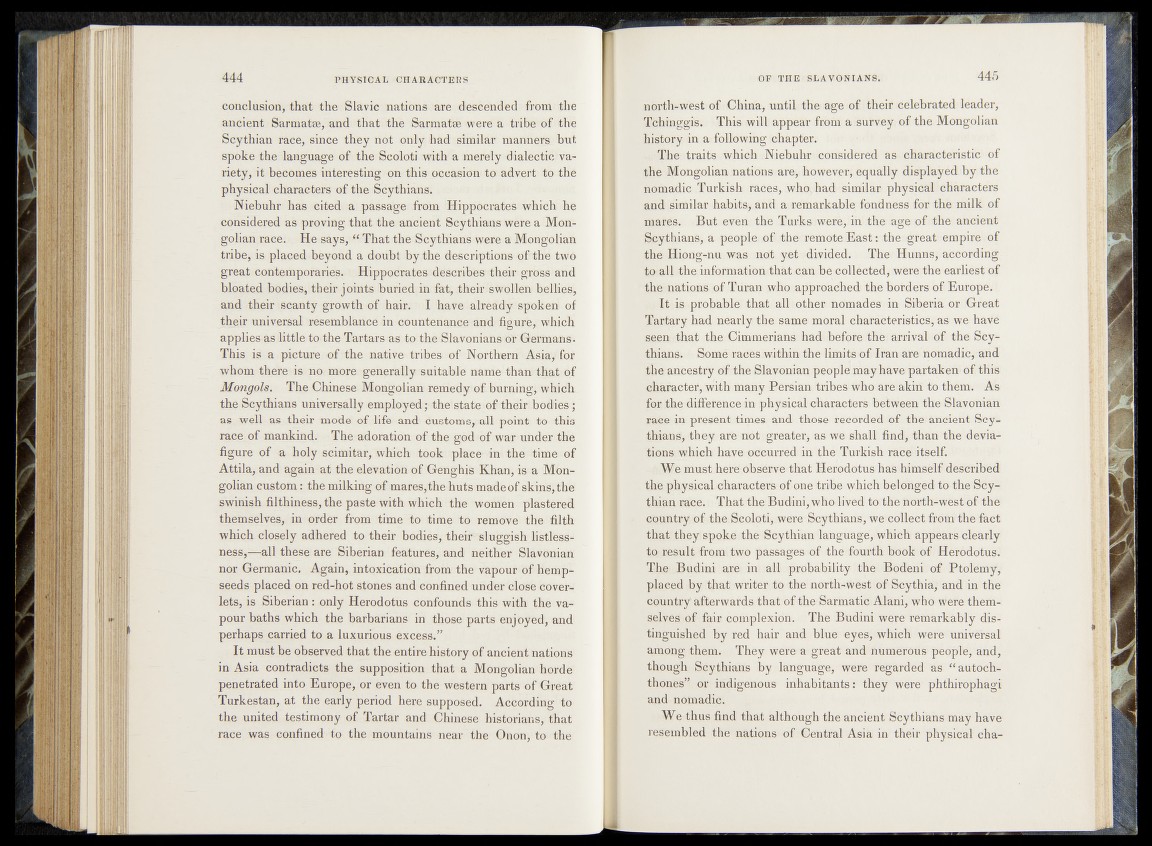
conclusion, that the SlSvie nations tate Spoilt the
ancient s Sarmaiag,and that the Sarmatae wer#hr-I»fc' ©f the
Scythian race, since they hot only had similar manners, but.
spoke the language of the Seoloti with a merely dialectic) variety,
it becomes interesting on th isoceasionito advert? lo the
physical characters of the Scythians.
Niebuhr has cited a passage from Hippocrates which he
considered as proving that the ancient Scythians weie a ^Mongolian,
raee.K<> He says, ^ That theiScythians were a Mongolian
tribe j is placed shtfeyand a doubt by the descriptions ©Mbe two
great contemporaries. Hippocrates:describ,esf-their' grbsS) and
bloated bodie&jitheir joints buried-in fet* their swollen bellies*,
and their scanty growth of hair. I have already?spok eh of
their universal resemblance in countenanc_e*andf'fig'iare, which
applies as little tot the Tartars as to thevSlavonians* or Germans^
This is a picture of the n atitetrib es4 of^iterthern ’Asiayfor
whom there is no more generally suitable nameth&n"3?tfeatj of
Mongols. The Chinese Mongolian’-remedy ©fiburnihgj which
the Scythians universally employed; the s ta te o f their!befiHies;
as well as their mode of life and dustomsy all point to this
race of mankind. The adoration of the. g©d)bf war under the
figure of a holy scimitar, which took place in* the time of
Attila, and again at the elevation of‘Genghis Khan, is-a Mongolian
custom: the milking o f mares,the huts madeof skinsfflfe
swinish filthiness, the paste with which the womien plastered
themselves, in order from time to time to remdve the filth
which, closely adhered to their bodies, tbeirialuggish; listl'ess-
ness,—all these are Siberian features, and neither Slavonian
nor Germanic. Again, intoxication from the vapour 'Of hemp-
seeds placed on red-hot stones and confined und'er close bover-
lets, is Siberian: only Herodotus confounds this with the vapour
baths which the barbarians in those parts enjoyed, and
perhaps carried to a luxurious excess.
I t must he observed that the entire history of ancient nations
in Asia contradicts the supposition that a Mongolian horde
penetrated into Europe, or even to the western parts of Great
Turkestan, at the early period here supposed. According to
the united testimony of Tartar and Chinese historians, that
race was confined to the mountains near the Onon, to the
north* west of (China, untihthe- ag eo f their celebrated leader,
Tohitaggfe.. This will appear from a survey of the Mongolian
history in a following 'chapter.- j
...;-^erfrai|^whlAylS*i>uhrl©emsiderdd:aS' characteristic of
the Mongolian.natioiiS'areyhoweverj equally displayeckby the
ftomadic ,Turkish'?' races, jwho^had similar physical characters
and similar h a b ita n t! a remarkable fondness for the milk of
mares. But .^curthe^ TnHksfJwere,iin thenagevoff the ancient
^ythrians, a peoplei ©f the- remotaEast: .the great empire of
th e Hiong-nu was ®@jb yet divided. The IIunns, according
t,Of.allithednformation that can hc oollectedy-were the earliest of
the nations',of Turan who approached the borders of Europe.
( It is ipgobable; .that;,alii other nomades* in-Siberia or Great
Tartary had nearly the same moral characteristics, as we have
seen 'that the Cimmerians, had- before tshej arrival of the Scythians.
a Some races within the limits'of Iran are HOMadic^and
thu ancestry of the Slavonian peopleLmay have partaken* of. this
(ihatactei*, with many Persian, driblet who are'akiii to them. As
for the difference in physical characters between the Slavonian
rate in presantvtiin.es and those Eebtbrded of the ancient Sey-
tbian^,-ihegrare not .greater.* as we shall find, than the deviations
which have-occurred mrfche Turkish race* itself.
We must here observe that Herodotus- has himself described
thh physical.characters of one -tribe wjhichvbelonged to the Scythian
race, ; That the Budini, who lived to th,e north-west of th #
country of d>ha Seoloti;, ;were Scythians, we collect from the fact
that they spoke the Scythian language, which appears clearly
to-result from-two passages of ^thetfourth book of Herodotus^
The Budini are in all probability the Bodeni. of Ptolemy,
placed by riiat writer to the'north-west of Scythia, and in the
country' afterwards that of the Sarmatic Alani, who were themselves
of fair complexkjn... The Budini wore remarkably distinguished
by red hair and blue eyes, which were* universal
among them.. . They were a great and numerous’ people, and,
though Scythians by language, were regarded as “ autochthones”
or indigenous inhabitants: they were phthirophagi
and nomadic.
We thus find that although the ancient Scythians may have
resembled the nations of Central Asia in their physical cha